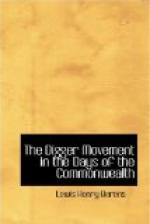In fact, religious and political speculation, as well as dissatisfaction and discontent, were rife amongst the active and thoughtful of the people, as well as in the Army. On the 17th of the previous month, some of the soldiers, who, according to Gardiner,[87:1] “had resolved not to leave England till the demands of the Levellers [the political Levellers] had been granted—300 in Hewson’s regiment alone,” had refused to go to Ireland, and had been promptly cashiered. On April 24th a dispute about pay in one of the troops of Whalley’s regiment had resulted “in some thirty of the soldiers seizing the colours and refusing to leave their quarters.” It was not till Cromwell and Fairfax appeared on the scene that they submitted. Fifteen of their number were carried to Whitehall, where, on the 26th, a Court-martial condemned six of them to death. “Cromwell, however, pleaded for mercy, and in the end all were pardoned with the exception of Robert Lockyer, who was believed to have been their leader.” Lockyer, Gardiner continues, “though young in years, had fought gallantly through the whole of the war. He was a thoughtful, religious man, beloved by his comrades, who craved for the immediate establishment of liberty and democratic order. As such he had stood up for The Agreement of the People on Corkbush Field,” when another trooper of a similar character, named Arnold, had been shot to death, “and he now entertained against his commanding officers a prejudice arising from other sources than the mere dispute about pay, which influenced natures less noble than his own.... On the 27th, Lockyer, firmly believing himself to be a martyr to the cause of right and justice, was led up Ludgate Hill to the open space in front of St. Paul’s, and there, after expostulating with the firing party for their obedience to their officers in a deed of murder, he was shot to death.”
Lockyer’s funeral took place on the 29th, and was the occasion of a remarkable demonstration, of which we take the following account from the pages of Whitelocke’s Memorial of English Affairs (p. 399):
“Mr. Lockier a Trooper who was shot to death by Sentence of the Court Martial was buried in this manner. About one thousand went before the Corps, and five or six in a file, the Corps was then brought with six Trumpets sounding a Soldier’s Knell, then the Trooper’s Horse came clothed all over in mourning and led by a Footman. The Corps was adorned with bundles of Rosemary, one half stained with blood, and the Sword of the deceased with them. Some thousands followed in Ranks and Files, all had Sea-green and black Ribbon tied on their Hats and to their Breasts, and the Women brought up the Rear. At the new Church Yard in Westminster some thousands more of the better sort met them, who thought not fit to march through the City. Many looked on this Funeral as an Affront to the Parliament and Army; others called them Levellers, but they took




